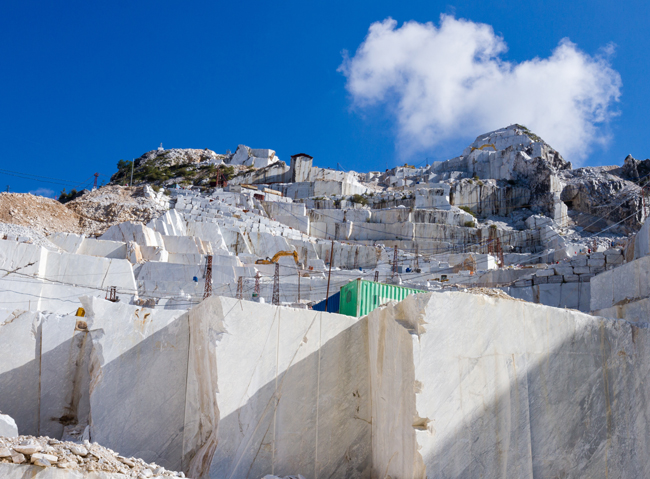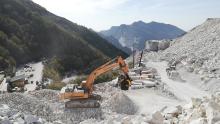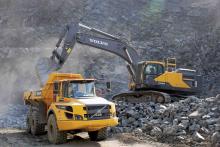
Construction equipment sales were healthy in 2018, but uncertainty over the policies of the new Italian government is leading to caution over further investments in aggregates and construction equipment. Liam McLoughlin reports.
Construction equipment sales in Italy jumped 22% year on year to reach 9,615 units for the first nine months of 2018.
The figures reflect the continuing recovery of construction equipment sales in recent years, following one of the most serious recessions in Italian history.
Sales of earthmoving machines were up 23% to 9,281 units compared with 7,551 units during the same period in 2017, according to Italian construction equipment trade association Unacea.
The biggest percentage increase in sales was for wheeled excavators which rose by 65% from 111 in January-September 2017 to 183 for the corresponding period in 2018. Articulated dump truck (ADT) sales increased from 34 in January-September 2017 to 51 for the same period in 2018, up by 59%.
“The positive sales trend in the Italian market continued during the third quarter,” said Antonio Strati, Unacea councillor in charge of statistics activities.
“However, it should be remembered that in terms of units, 2018 sales stood at the same levels of the early nineties. The recovery exists, but the persisting uncertainty in national economic policies and the international financial situation could put a strain on it,” he said.
The Italian Institute for Statistics – ISTAT - reported an increase of 0.6% in construction investments in August. According to the Construction Monitor of the
The restrained development in the sector can predominantly be attributed to suspension of work in numerous infrastructure projects, with difficulties related to the new public procurement legislation and to the implementation of local government budgets.
While Italy´s construction sector continued to grow in recent years, the industry is still far away from a real rebound, according to Italian construction association ANCE, which says that construction investments in the country fell by more than 35% between 2007 and 2016. ANCE adds that construction investment increased by only 0.2% in 2017, driven by restorations (up 0.5%) and non-residential building activity (up 0.6%), while the new residential building segment continued to decline (falling by 1.5%).
A significant number of plant and machines are standing still, i.e. not working at all and/or working very few hours per year (0-500 hours), according to Ángel Luis García del Val, distribution business manager for Italy in the aggregates area at OEM (original equipment manufacturer)
“In addition, some new machines sold between 2015-2018 in the Italian market are not installed yet,” he adds.
Construction equipment sales were partly inflated in 2017 and 2018 by the tax benefits provided in two recent pieces of fiscal legislation. The Super Ammortamento and the Iper Ammortamento were introduced in the last two governments’ financial laws. These fiscal incentives now appear to have been cancelled, however, with neither at the moment being included in the draft of the 2019 Italian government financial law.
The current political situation in Italy and the low volume of civil work do not help the trust of customers for making investments in quarrying equipment, according to García del Val. “On the other hand, the quarrying machinery installed base is getting older and customers clearly know they must upgrade the plants to keep production costs at a low level,” he adds. For the moment, he says that large construction projects in Italy are proceeding very slowly and some of them could be in doubt after the new Italian government raised doubts over their current economic viability.
“Some of them will probably be postponed due to the lack of money and their cost,” he says. “We believe clearer details will be available in the first quarter of 2019 after the approval of the 2019 Government Financial Law, currently being discussed with EU in Brussels.
“In the short term, we don’t expect a huge increase in the demand for aggregates because the majority of these projects are still to be defined. They may impact the future re-start of some of the stopped plants and the need for more spares.”
Commenting on the prospects for the Italian quarrying and aggregates sector over the next 18 months, Stefano Tacchinardi, MD of the
In terms of the type of equipment that Italian quarry operating customers are currently looking for, Tacchinardi commented: “Machines that further develop efficiency in order to reduce customer operating costs.”
García del Val says: “In the areas of hard stone, cone crushers and jaw crushers are the most popular machines due to the abrasiveness and hardness of the rock deposits [in Italy].”
The value of Italian construction machinery exports totalled €2.18bn in the first nine months of 2018, an increase of 6.2% compared to the same period in 2017, according to the latest surveys made available by the organisers of Italian construction exhibition SaMoTer.
Italian-built earthmoving machinery and equipment took the largest share of orders from abroad, worth more than €1bn (+13%). Then came machinery for preparing aggregates (€382mn / +0.9%), drilling (€276mn / -0.9%) and concrete (€211mn / -3%). Exports of tower cranes also performed well (€196mn / +10.7%), while road-building machinery came to €93mn, down by 3.6%.
In terms of destination markets, Western Europe confirmed its status as the predominant area in the third quarter of 2018 (€915mn, +6.9%); North America took second place (€287mn, +19.6%) and Central-Eastern Europe plus Turkey ranked third (€275.8mn, +14%). Exports increased to the Middle East (€108mn, +4.4%) and to India (€42mn, +6.8%). Downturns were posted by Central and South America (€99.7mn, -17.75%), North African countries (€75mn, -12.9%), Russia (€56mn, -0.2%) and China (€46mn, -1.4%).
In the Italian domestic market, imports of construction and site machinery and equipment between January and September came to €710.5mn, up by 14.4% over the first nine months in 2017.
The ongoing recovery in the Italian construction sector contributed to results for vehicle and machinery imports, according to data analysed by the SaMoTer - Prometeia Outlook which indicated a growth in investments of 0.5% in the third quarter of the year. SaMoTer is the Italian construction exhibition held every three years in Verona. The next edition is scheduled to take place in March 2020.
SaMoTer predicted that construction vehicle and machinery imports for full-year 2018 were likely to total €140.5bn, up by 1.9% on the previous year. Residential construction (2.6%) was once again the driving force for the industry in 2018, thanks to renovations and energy requalification projects; the non-residential sector also performed well (+1.7%), while public works are still struggling to take off (+0.3%).
For the next two years, the Prometeia Outlook estimates further expansion by 2.1% per year on average, mainly due to the strong impact of public funding in civil engineering, with a 2.5% increase in total infrastructure investments expected in 2019, followed by a further 6% increase in 2020.
The organisers of SaMoTer commented: “These are encouraging signals during the run-up to the 31st edition of SaMoTer, the only event in Italy dedicated to all construction equipment sectors scheduled at Veronafiere 21-25 March 2020 with a thematic focus on innovation and efficiency improvements of technologies.”
Italy is among the world leaders in the natural stone, and particularly marble, quarrying sector which is mainly located in the Carrara area of Tuscany. The sector is important for both domestic and export sales and one of its main showcases is the Marmomac trade fair, the latest edition of which was held at Veronafiere in September 2018.
“Natural stone, and the technology and machinery industry associated with it, is synonymous with quality and Italy is the acknowledged leader in this context,” said Giovanni Mantovani, director general of Veronafiere.
He added that Italy ranks second in the world in terms of natural stone sales with a positive balance of €2.8bn a year.
“The processed [natural stone] products sector, which is often affected by geopolitical situations, includes among its main customers the United States, Germany, Switzerland, United Kingdom, France, as well as the
United Arab Emirates and China,” Mantovani added.







